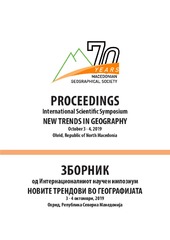Приказ основних података о документу
Role of Spatial Planning in Managing Mountain Areas in Serbia and other European Countries
| dc.creator | Pantić, Marijana | |
| dc.creator | Milijić, Saša | |
| dc.creator | Djordjević, Dejan S. | |
| dc.date.accessioned | 2020-01-10T11:59:55Z | |
| dc.date.available | 2020-01-10T11:59:55Z | |
| dc.date.issued | 2019 | |
| dc.identifier.isbn | 978-608-65155-6-0 | |
| dc.identifier.uri | https://raumplan.iaus.ac.rs/handle/123456789/526 | |
| dc.description.abstract | In comparison to densely populated coastal areas and lowlands, geomorphological configuration of mountain areas makes them specific in various aspects. However, not all European mountain countries recognize the specifics of their mountain areas in the same way, if at all, in spite of their exceptional value. A decade after the 2002 – International Year on Mountains, the focus has been shifted away from these areas. Therefore, this article brings back the topic of Serbian and other European mounting areas in the focus, by reviewing so far developed management tools whose future improvements could enforce their development, secure primary values and make them more competitive. The particular attention is given to spatial planning as a comprehensive development tool. The article presents a short review of major European management paradigms that have been developed so far, with particular insight into the system developed in Serbia. The data analysed here origin from literature and interviews that have been conducted with representatives of ministries and local government in Serbia. Different paradigms are compared and discussed in light of theoretical stands on integrative approach, planning horizons, cooperation, participation and elements in a planning cycle. The aim was to embrace examples from largest European mountain massifs such as Alps, Pyrenees, Carpathians and Balkan Mountains. As the result, here are indicated possibilities and need for specific tools in spatial planning and management of mountain areas. The advantages and differences in approaches are accentuated, thus creating a foundation for further learning and improvements of a management system and spatial planning for mountain areas as entities of special characteristics and special needs. | en |
| dc.language.iso | en | sr |
| dc.publisher | Macedonian Geographical Society | sr |
| dc.relation | info:eu-repo/grantAgreement/MESTD/Technological Development (TD or TR)/36036/RS// | sr |
| dc.rights | openAccess | sr |
| dc.rights.uri | https://creativecommons.org/licenses/by-nc-nd/4.0/ | |
| dc.source | International Scientific Symposium "New Trends in Geography" - Book of Proceedings, 3-4 October, Ohrid, North Macedonia | sr |
| dc.subject | European mountain areas | sr |
| dc.subject | Evropska planinska područja | sr |
| dc.subject | spatial planning | sr |
| dc.subject | prostorno planiranje | sr |
| dc.subject | mountain massifs | sr |
| dc.subject | planinski masivi | sr |
| dc.subject | management | sr |
| dc.subject | upravljanje | sr |
| dc.title | Role of Spatial Planning in Managing Mountain Areas in Serbia and other European Countries | en |
| dc.type | conferenceObject | sr |
| dc.rights.license | BY-NC-ND | sr |
| dcterms.abstract | Пантић, Маријана; Дјордјевић, Дејан С.; Милијић, Саша; | |
| dc.citation.spage | 373 | |
| dc.citation.epage | 385 | |
| dc.citation.rank | M33 | |
| dc.identifier.fulltext | https://raumplan.iaus.ac.rs/bitstream/id/2310/Ohrid_Pantic_Milijic_Djordjevic.pdf | |
| dc.identifier.rcub | https://hdl.handle.net/21.15107/rcub_raumplan_526 | |
| dc.type.version | publishedVersion | sr |

